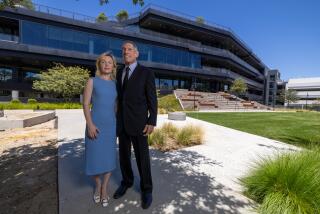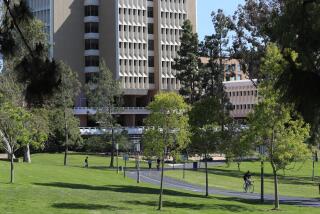UCSD Opens Dual-Usage Molecular Genetics Lab
- Share via
Hoping to weave ties to private biotechnology firms and promote research in the rapidly expanding field of molecular genetics, UC San Diego has begun drawing together researchers from across the campus under the roof of a new $8-million Center for Molecular Genetics.
The facility, to be inaugurated on the La Jolla campus today, is to house seven molecular genetics laboratories, a computer for analyzing genes and proteins and a “pay-as-you-go” gene- and protein-synthesizing service operating round the clock.
University officials say the center is a rarity, if not unique, in its attempts both to encourage interaction between labs working in molecular genetics and to create a community resource shared by academics and private biotechnology firms.
Troublesome Challenges
But its director acknowledged Wednesday that the center also presents troublesome challenges--both in attempting to respect the divergent aims of academia and industry and in addressing the “very sticky issues” raised by genetic research.
“It may be somewhat of a challenge, but we’re determined to do this while safeguarding academic principles and values, in terms of the free flow of information, and appreciating the values and proprietary interests of the biotechnology companies,” said Donald Helinski, the biology professor who heads the center.
“It’s clear that these powerful techniques of molecular genetics are going to raise certain social issues--let’s say, legal, ethical, moral issues,” Helinski added, speaking at a press briefing. He said he hoped the center might serve as a forum in which specialists, as well as the public, might discuss those issues.
Molecular genetics, also known as recombinant DNA research, involves the isolation and manipulation of genes from humans, animals, plants and micro-organisms, and their insertion into the chromosomes of cells from a variety of organisms.
Researchers use those techniques, developed almost entirely since the mid-1970s, to study the molecular structure of genes and to explore the regulation of gene expression throughout an animal’s or plant’s development.
A Single Home
More than 50 labs use molecular genetic techniques at UCSD, which Helinski described as one of the top 10 U.S. universities in the field. He said the large concentration of biotechnology firms nearby is among the top four such concentrations in the world.
The UCSD center was established in 1984 but until today did not have a single home.
“I think it’s fair to say that molecular genetics . . . represents the single greatest advance in natural sciences in this half of the 20th Century,” Helinski said. He said the research has enhanced understanding of the body, health and disease and is beginning to play a role in medical therapy.
According to the university, the center will focus on four areas of research:
- Developmental biology, or using recombinant DNA techniques to analyze the control of gene expression throughout and organism’s development and thus understand the control of normal, as well as abnormal, development.
- Human heredity, or studying genes to determine the changes in gene structure that are responsible for certain hereditary diseases. Researchers say they may eventually be able to treat certain hereditary conditions with gene therapy.
- Plant molecular biology, or probing plant genes toward genetic manipulation of plant material. One aim is to alter the growth and nutritional properties of plants and enhance their ability to resist such things as temperature extremes and disease.
- Microbiology, or the study of gene expression in microorganisms in the hope of using microorganisms for medical and agricultural products. Bacterial and yeast cells have already been engineered to produce such things as human hormones, vaccines and blood clotting factors.
Helinski said the center’s first priority will be its own research. But an important objective also will be “to interact with the biotechnology community, to provide access for these companies to our resources here at the center.”
For example, an investigator might use the system’s computer to compare the structure of a gene he or she is studying with data on other genes that have been analyzed previously. The computer is eventually to be hooked in to the powerful San Diego supercomputer.
Other services to industry include synthesizing genes, protein or pieces of a genes.
“What we will provide, I think, is a very high quality operation,” Helinski said, describing the service offered by researcher Louise Schmidt as though he were describing a landscape gardening or pest-control service. “ . . . The quality of her products is excellent. And we are in close proximity to the biotechnology companies. It is a rather simple matter for them to come to this facility, sit down with Louise, go over their needs and make sure they get the product they want.”
Price of a Gene
Helinski said the bill for making a piece of a gene averages about $500, depending on its size. The price for a piece of protein would range from $500 to $1,000.
Helinski said he could see no difficulties when firms use the facility on a fee-for-service basis or when they provide money to support symposiums or conferences at the center on subjects of special interest to them.
The problems can arise when companies fund a researcher’s work, he said.
There must be rules to ensure that the funding does not “interfere with or compromise” the training of students, Helinski said. There must also be “some agreement with the biotech companies so that their proprietary interests are protected.”
“Possible dilemmas” also arise in cases in which research scientists have vested interests in firms that support their research. Helinski noted that a faculty committee on such questions must approve all such arrangements.
Another area of controversy has centered on what might be done with tools that can, for example, predict hereditary diseases. Observing that such possibilities have raised “rather profound issues,” Helinski said he hoped the center would become a forum for discussion.
Helinski also called for a coordinated move by federal agencies to develop a common set of guidelines for field tests of such things as the genetically altered bacteria currently being tested on strawberry plants in Northern California. But he dismissed critics’ fears of unintended or sinister uses of molecular genetic techniques.
“I don’t think the idea of breeding Andromeda strains or genetically engineering people’s behavioral traits is any more a point of concern,” Helinski said. “ . . . Even if we wanted to design, for example, an individual with new behavioral traits or to design a more deadly organism than the AIDS virus or (others) that are naturally occurring, we simply could not do it.”
The center, which opens today with a two-day symposium featuring specialists from across the country, was paid for out of discretionary university funds, loans and grants. It is expected to cost up to $4 million a year to operate, paid for through research grants.






